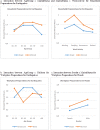Natural disaster preparedness in a multi-hazard environment: Characterizing the sociodemographic profile of those better (worse) prepared
- PMID: 31017910
- PMCID: PMC6481794
- DOI: 10.1371/journal.pone.0214249
Natural disaster preparedness in a multi-hazard environment: Characterizing the sociodemographic profile of those better (worse) prepared
Abstract
The growing multi-hazard environment to which millions of people in the world are exposed highlights the importance of making sure that populations are increasingly better prepared. The objective of this study was to report the levels of preparedness of a community exposed to two natural hazards and identify the primary sociodemographic characteristics of groups with different preparedness levels. A survey was conducted on 476 participants from two localities of the Atacama Region in the north of Chile during the spring of 2015. Their level of preparedness at home and work was assessed to face two types of natural hazards: earthquakes and floods.The findings show that participants are significantly better prepared to face earthquakes than floods, which sends a serious warning to local authorities, given that floods have caused the greatest human and material losses in the region's recent history of natural disasters. Men claimed to be more prepared than women to face floods, something that the authors attribute to the particular characteristics of the main employment sectors for men and women in the region. The potential contribution of large companies on preparedness levels of communities in the areas in which they operate is discussed. The sociodemographic profile of individuals with the highest levels of preparedness in an environment with multiple natural hazards are people between 30 and 59 years of age, living with their partner and school-age children. The implications of the results pertaining to institutions responsible for developing disaster risk reduction plans, policies and programs in a multi-hazard environment are discussed.
Conflict of interest statement
The authors have declared that no competing interests exist.
Figures


References
-
- Dilley M, Chen U, Deichmann RS, Lerner-Lam A, Arnold M. Natural disaster hotspots: a global risk analysis. Washington DC: World Bank Publications; 2005.
-
- IPCC. Managing the risks of extreme events and disasters to advance climate change adaptation: special report of the intergovernmental panel on climate change: Cambridge University Press; 2012. - PubMed
-
- CRED. Human Cost of Natural Disasters A Global Perspective. Center for Research on the Epidemiology of Disasters, 2015.
-
- CRED. Natural disasters in 2017: Lower mortality, higher cost 2018. Available from: https://www.emdat.be/publications.
-
- Mohan PS, Ouattara B, Strobl E. Decomposing the Macroeconomic Effects of Natural Disasters: A National Income Accounting Perspective. Ecological Economics. 2018;146:1–9.
Publication types
MeSH terms
LinkOut - more resources
Full Text Sources
Medical

